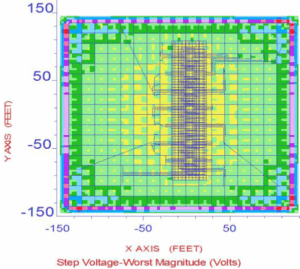Ensure safety and compliance with a comprehensive substation ground grid analysis and design. We evaluate soil resistivity, fault current, and voltage hazards, and provide a custom-engineered grounding solution that meets IEEE and NESC standards.

Fault events can result in dangerous voltage gradients that pose serious safety risks. Without a properly designed ground grid, step, touch, and transfer potentials can exceed safe limits, endangering personnel and infrastructure.
- Personnel safety
- Touch potentials
- Step potentials
- Transfer voltages
- Regulatory liability

What the Service Includes
Soil Resistivity Testing
Fault Current Analysis
Touch & Step Potential Assessment
Engineered Ground Grid Design
Before-and-After Simulation
Final Report & Documentation
Applicable Codes & Standards
IEEE 80-2013
IEEE Guide for Safety in AC Substation Grounding
IEEE 81-2012
IEEE Guide for Measuring Earth Resistivity, Ground Impedance, and Earth Surface Potentials of a Grounding System
EEE 81.2-1992
IEEE Guide for Measurement of Impedance and Safety Characteristics of Large, Extended or Interconnected Grounding Systems
IEEE 142-2007
IEEE Recommended Practice for Grounding of Industrial and Commercial Power Systems (“Green Book”)
IEEE 142-1991
IEEE Recommended Practice for Grounding of Industrial and Commercial Power Systems (“Green Book”)
IEEE 367-2012
IEEE Recommended Practice for Determining the Electric Power Station Ground Potential Rise and Induced Voltage from a Power Fault
IEEE 487-2015
IEEE Recommended Practice for the Protection of Wire-Line Communication Facilities Serving Electric Supply Locations
IEEE 525-2025
IEEE Guide for the Design and Installation of Cable Systems in Substations
IEEE 837-2024
IEEE Standard for Qualifying Permanent Connections Used in Substation Grounding
IEEE 1100-2005
IEEE Recommended Practice for Powering and Grounding Electronic Equipment (“Emerald Book”)
IEEE C37.122-2021
IEEE Standard for High-Voltage Gas-Insulated Substations Rated Above 52 kV
IEEE C37.122.1-2014
IEEE Guide for Gas-Insulated Substations Rated Above 52 kV
NESC C2-2023
National Electrical Safety Code (NESC), 2023 Edition
